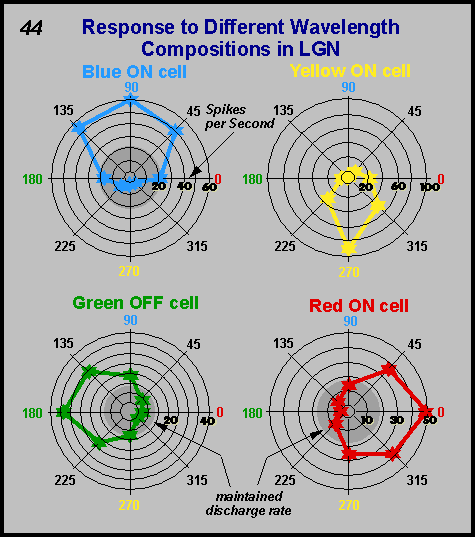The Neural
Control of Vision
J. The Processing of Color
 We
can now proceed to ask how color is processed in the nervous system. One
thorny problem is that there are only three kinds of cones, yet we process
color by talking about red and green and blue and yellow. This comes about
the way the three cone types are combined and are laid out in opposition
with each other in the nervous system. Remarkably, it has been discovered
that in retinal ganglion cells and in the lateral geniculate nucleus color
is processed along just four axes of the color circle. Examples of this
appear in Figure 44 in which the
color circle is shown head on. Cells are shown that peak at blue, yellow,
green and red. Extensive sampling showed only these classes, although
red and green cells come in both ON and OFF subvarieties. The blue and
yellow most commonly come as ON subtypes.
We
can now proceed to ask how color is processed in the nervous system. One
thorny problem is that there are only three kinds of cones, yet we process
color by talking about red and green and blue and yellow. This comes about
the way the three cone types are combined and are laid out in opposition
with each other in the nervous system. Remarkably, it has been discovered
that in retinal ganglion cells and in the lateral geniculate nucleus color
is processed along just four axes of the color circle. Examples of this
appear in Figure 44 in which the
color circle is shown head on. Cells are shown that peak at blue, yellow,
green and red. Extensive sampling showed only these classes, although
red and green cells come in both ON and OFF subvarieties. The blue and
yellow most commonly come as ON subtypes.
The blue cones shown here are now believe to connect predominantly to
the koniocellular ganglion cells which in turn project to the intralaminar
layers of the
LGN. The projections from these layers are predominantly to the upper
layers of area V1 as depicted in Figure 10.
(Chichilinsky and Baylor (1999) Nature Neuroscience, 2, 889-893; Dacey, et al. (2003) Neuron, 37, 15-27)